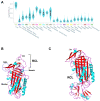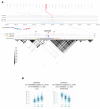Known Mutations at the Cause of Alpha-1 Antitrypsin Deficiency an Updated Overview of SERPINA1 Variation Spectrum
- PMID: 33790624
- PMCID: PMC7997584
- DOI: 10.2147/TACG.S257511
Known Mutations at the Cause of Alpha-1 Antitrypsin Deficiency an Updated Overview of SERPINA1 Variation Spectrum
Abstract
Alpha-1-Antitrypsin deficiency (AATD), caused by SERPINA1 mutations, is one of the most prevalent Mendelian disorders among individuals of European descend. However, this condition, which is characterized by reduced serum levels of alpha-1-antitrypsin (AAT) and associated with increased risks of pulmonary emphysema and liver disease in both children and adults, remains frequently underdiagnosed. AATD clinical manifestations are often correlated with two pathogenic variants, the Z allele (p.Glu342Lys) and the S allele (p.Glu264Val), which can be combined in severe ZZ or moderate SZ risk genotypes. Yet, screenings of AATD cases and large sequencing efforts carried out in both control and disease populations are disclosing outstanding numbers of rare SERPINA1 variants (>500), including many pathogenic and other likely deleterious mutations. Generally speaking, pathogenic variants can be subdivided into either loss- or gain-of-function according to their pathophysiological effects. In AATD, the loss-of-function is correlated with an uncontrolled activity of elastase by its natural inhibitor, the AAT. This phenomenon can result from the absence of circulating AAT (null alleles), poor AAT secretion from hepatocytes (deficiency alleles) or even from a modified inhibitory activity (dysfunctional alleles). On the other hand, the gain-of-function is connected with the formation of AAT polymers and their switching on of cellular stress and inflammatory responses (deficiency alleles). Less frequently, the gain-of-function is related to a modified protease affinity (dysfunctional alleles). Here, we revisit SERPINA1 mutation spectrum, its origins and population history with a greater emphasis on variants fitting the aforementioned processes of AATD pathogenesis. Those were selected based on their clinical significance and wider geographic distribution. Moreover, we also provide some directions for future studies of AATD clinically heterogeneity and comprehensive diagnosis.
Keywords: MMalton allele and QOurém allele; S allele; SERPINA1 variants; Z allele.
© 2021 Seixas and Marques.
Conflict of interest statement
The authors have no competing interests to declare.
Figures




Similar articles
-
Alpha-1-antitrypsin (SERPINA1) mutation spectrum: Three novel variants and haplotype characterization of rare deficiency alleles identified in Portugal.Respir Med. 2016 Jul;116:8-18. doi: 10.1016/j.rmed.2016.05.002. Epub 2016 May 3. Respir Med. 2016. PMID: 27296815
-
New cis-Acting Variants in PI*S Background Produce Null Phenotypes Causing Alpha-1 Antitrypsin Deficiency.Am J Respir Cell Mol Biol. 2020 Oct;63(4):444-451. doi: 10.1165/rcmb.2020-0021OC. Am J Respir Cell Mol Biol. 2020. PMID: 32515985
-
Identification and characterisation of eight novel SERPINA1 Null mutations.Orphanet J Rare Dis. 2014 Nov 26;9:172. doi: 10.1186/s13023-014-0172-y. Orphanet J Rare Dis. 2014. PMID: 25425243 Free PMC article.
-
Rare variants in alpha 1 antitrypsin deficiency: a systematic literature review.Orphanet J Rare Dis. 2024 Feb 22;19(1):82. doi: 10.1186/s13023-024-03069-1. Orphanet J Rare Dis. 2024. PMID: 38388492 Free PMC article. Review.
-
Variants of SERPINA1 and the increasing complexity of testing for alpha-1 antitrypsin deficiency.Ther Adv Chronic Dis. 2021 Jul 29;12_suppl:20406223211015954. doi: 10.1177/20406223211015954. eCollection 2021. Ther Adv Chronic Dis. 2021. PMID: 34408833 Free PMC article. Review.
Cited by
-
Targeting the Liver with Nucleic Acid Therapeutics for the Treatment of Systemic Diseases of Liver Origin.Pharmacol Rev. 2023 Dec 15;76(1):49-89. doi: 10.1124/pharmrev.123.000815. Pharmacol Rev. 2023. PMID: 37696583 Free PMC article. Review.
-
Diagnosis and augmentation therapy for alpha-1 antitrypsin deficiency: current knowledge and future potential.Drugs Context. 2023 Jul 20;12:2023-3-1. doi: 10.7573/dic.2023-3-1. eCollection 2023. Drugs Context. 2023. PMID: 37521109 Free PMC article. Review.
-
Characterization of Novel Alpha-1-Antitrypsin Coding Variants in a Mammalian Cellular Model.Methods Mol Biol. 2024;2750:79-93. doi: 10.1007/978-1-0716-3605-3_8. Methods Mol Biol. 2024. PMID: 38108969
-
Clinical characterization of a novel alpha1-antitrypsin null variant: PiQ0Heidelberg.Respir Med Case Rep. 2022 Jan 3;35:101570. doi: 10.1016/j.rmcr.2021.101570. eCollection 2022. Respir Med Case Rep. 2022. PMID: 35028284 Free PMC article.
-
Sirtuin3 promotes the degradation of hepatic Z alpha-1 antitrypsin through lipophagy.Hepatol Commun. 2024 Jan 29;8(2):e0370. doi: 10.1097/HC9.0000000000000370. eCollection 2024 Feb 1. Hepatol Commun. 2024. PMID: 38285890 Free PMC article.
References
Publication types
LinkOut - more resources
Full Text Sources
Other Literature Sources
Medical
Research Materials
Miscellaneous

